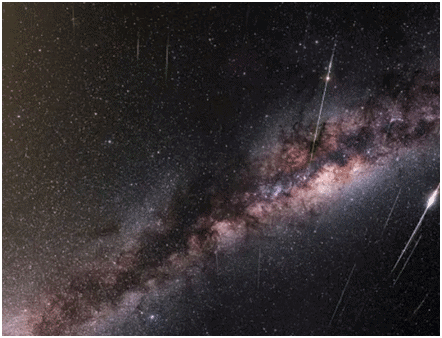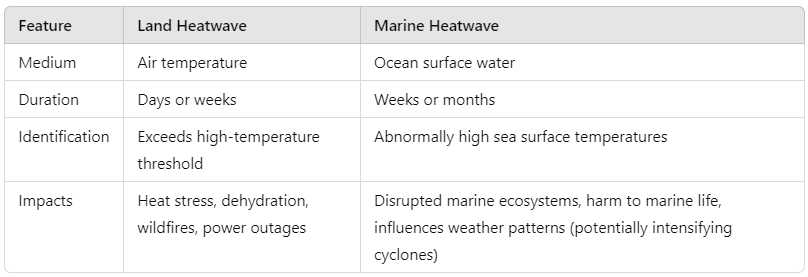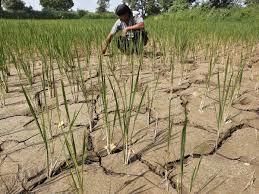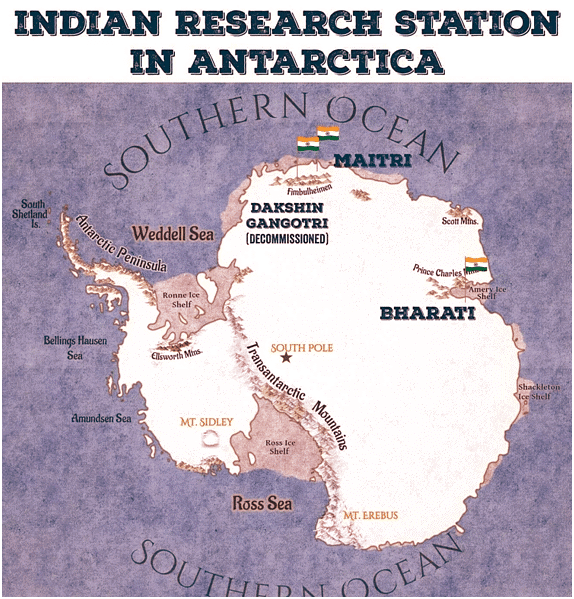Geography: May 2024 UPSC Current Affairs | Current Affairs & Hindu Analysis: Daily, Weekly & Monthly PDF Download
Aurora Borealis in India
Why in News?
Recently, auroras, usually seen in high-latitude areas like the North and South Poles, were spotted globally, even in regions where they are rarely seen. In India, these auroras were detected using all-sky cameras placed at the Indian Astronomical Observatory (IAO) in Hanle, Ladakh.
Aurora Phenomenon

About:
- Auroras are luminous and colorful displays in the sky, resulting from energetic interactions in space between charged solar winds and the Earth’s magnetosphere.
- They occur when intense solar events eject charged particles into space, which then become trapped in Earth's magnetic field and interact with atmospheric atoms, leading to geomagnetic storms and the formation of auroras.
- The interplay of solar inputs, Earth's upper atmosphere responses, and movements of planetary and space particles collectively contribute to diverse auroral patterns and shapes.
- In the Northern Hemisphere, this phenomenon is known as the northern lights (aurora borealis), while in the Southern Hemisphere, it is called the southern lights (aurora australis).
Composition and Colors:
- Auroras are composed of gases and particles such as oxygen and nitrogen.
- When these particles collide with the atmosphere, they emit light energy.
- The colors visible in auroras vary depending on the type of gas involved and the altitude of the collision.
Impact:
- Auroras can induce power blackouts on Earth, disrupt satellites in space, pose risks to astronauts, and influence space weather across the entire Solar System.
Heat-Waves Threatens Litchi Farmers

Why in News?
Recently, Bihar’s Muzaffarpur district has been affected by high temperatures and scorching westerly winds, creating unfavorable conditions for litchi fruit cultivation.
- This has led to dire consequences for numerous litchi farmers, who were already concerned about reduced flowering this year due to erratic weather patterns.
What are the Challenges Associated with the Recent Heat Waves in Bihar?
- Impact of Heatwaves on Litchi Orchards:
- The intense heat and strong westerly winds have resulted in a significant drop in immature litchi fruits.
- The National Research Centre on Litchi (NRCL) recommends increased irrigation to combat rising temperatures and maintain moisture levels in orchards. However, small farmers find it challenging to bear the associated costs.
- Effect of Climate Change on Litchi Production:
- Litchi thrives under specific microclimatic conditions, ideally experiencing temperatures between 30-35°C during the critical second half of April for optimal fruit development.
- Deviation from this temperature range disrupts natural growth processes, leading to smaller and less sweet litchi fruits.
- Expected Reduced Harvest:
- The anticipated litchi harvest is likely to be delayed and could potentially be halved compared to previous years.
- Farmers are facing significant crop losses and are planning to seek government assistance to mitigate these losses.
- Muzaffarpur and its surrounding areas contribute nearly 40% of India's litchi production, underscoring the substantial national impact of a poor harvest in this region.
What are Heat Waves?
About:
- Heat waves are prolonged periods of excessively hot weather.
- The India Meteorological Department (IMD) defines a heatwave based on maximum temperatures reaching at least 40°C for Plains and 30°C for Hilly regions.
Based on Departure from Normal:
- Heat Wave: Departure from normal is between 4.5°C to 6.4°C.
- Severe Heat Wave: Departure from normal exceeds 6.4°C.
Based on Actual Maximum Temperature:
- Heat Wave: Actual maximum temperature is ≥ 45°C.
- Severe Heat Wave: Actual maximum temperature is ≥ 47°C.
IMD's Initiatives and Tools to Combat Heat Waves:
- Early Warning Systems:
- IMD issues timely forecasts and heatwave warnings several days in advance.
- They utilize a color-coded alert system (yellow, orange, red) to indicate the severity of heatwaves.
- Collaboration and Action Plans:
- IMD collaborates closely with the National Disaster Management Authority (NDMA) to develop and implement heat action plans.
- They conduct awareness campaigns to educate the public about heatwave risks, precautionary measures, and strategies to stay cool during extreme heat.
- Leveraging Technology:
- IMD provides mobile apps like "Mausam" to deliver weather updates, including heatwave alerts, directly to users' smartphones.
- They maintain a user-friendly website and actively use social media platforms to disseminate weather information and heatwave advisories.
Land Subsidence in Chenab Valley

Why in News?
Recently, there have been reports of land subsidence occurring in various parts of the Chenab Valley, particularly affecting the districts of Ramban, Kishtwar, and Doda, resulting in the destruction of several houses.
- Previously, landslides were common during rain and snowfall in the region, but over the last 10 to 15 years, there has been an increasing occurrence of land subsidence.
What is Land Subsidence?
About
- According to the National Oceanic and Atmospheric Administration (NOAA), land subsidence refers to the sinking or settling of the ground surface due to underground material movement.
- It can occur due to a variety of reasons, both natural and human-induced, such as the extraction of water, oil, or natural resources, mining activities, earthquakes, soil erosion, and soil compaction.
- Land subsidence can affect large areas like entire states or provinces, as well as small localized areas.
Causes
- Overexploitation of Underground Resources: Extraction of resources such as water, natural gas, and oil reduces pore pressure and increases effective stress, leading to ground subsidence. More than 80% of the world's extracted water is used for irrigation and agriculture, contributing significantly to ground subsidence.
- Extraction of Solid Minerals: Mining activities, especially coal mining, can create underground voids (goafs) that lead to ground sinking or subsidence.
- Load Exerted on Ground: The construction of tall buildings and heavy infrastructure exerts pressure on the ground, causing soil deformation and subsidence over time. Soil creep, the gradual downhill movement of soil due to gravity, also contributes to ground subsidence.
Examples:
- Jakarta, Indonesia, is experiencing severe land subsidence (25 cm/year) due to excessive groundwater extraction.
- In the Netherlands, land subsidence has been a significant issue due to the extraction of natural gas from underground reservoirs.
What are the Reasons for Land Subsidence in the Chenab Region?
- Geological Factors: The region contains soft sedimentary deposits and alluvial soils that are prone to compaction under the weight of structures and external forces like groundwater extraction.
- Unplanned Constructions and Urbanization: Rapid urbanization and unplanned construction in hilly areas increase pressure on the land, exacerbating subsidence.
- Hydroelectric Projects: Construction of hydroelectric projects alters natural water flows and can destabilize the land. For instance, Joshimath town faces subsidence near a hydroelectric station.
- Poor Drainage Systems: Inadequate drainage aggravates land subsidence through waterlogging, rising groundwater levels, soil erosion, and infrastructure damage.
- Geological Vulnerability: Scattered rocks covered with old landslide debris, including boulders and loose soil, have low bearing capacity and high pore pressure during monsoons.
Way Forward
- Sustainable and Regional Development Plan: Prioritize environmental preservation while developing the Himalayan region, leveraging natural resources like forests, water, biodiversity, and ecotourism responsibly.
- Implementing Efficient Water Management: Adopt practices such as rainwater harvesting and water recycling to reduce excessive groundwater extraction and alleviate subsidence.
- Continuous Seismic Monitoring and Early Warning Systems: Establish monitoring networks to track ground movements and seismic activity, providing early warnings of potential subsidence and earthquake risks.
- Regulating Mining and Resource Extraction: Enforce stringent regulations on mining and resource extraction to prevent underground voids that contribute to land subsidence.
- Climate Change Mitigation: Take measures to mitigate climate change impacts, including reducing greenhouse gas emissions and promoting sustainable practices to slow glacial melting and associated subsidence.
Eta Aquariid Meteor Shower

Why in News?
The Eta Aquariid meteor shower, which began on April 15, is set to peak on May 5 and 6.
- Comprising fast-moving space debris traveling at speeds of approximately 66 km per second (2.37 lakh kmph) into Earth’s atmosphere, these meteor showers occur annually in May. They are most visible from countries in the Southern Hemisphere such as Indonesia and Australia.
What are Comets?
About:
- Comets are small cosmic bodies composed of ice, dust, and frozen gases that orbit the Sun.
- They are often referred to as dirty snowballs and are believed to be remnants from the formation of the solar system around 4.6 billion years ago.
Composition:
- Comets consist of a nucleus, coma, hydrogen envelope, and dust and plasma tails.
- The nucleus is a loose aggregation of ice, dust, and small rocky particles ranging from a few hundred meters to tens of kilometers in diameter.
Location:
Comets are found in two main regions of the solar system:
- Kuiper Belt: A wide disk beyond Neptune's orbit containing short-period comets with orbital periods of less than 200 years.
- Oort Cloud: A spherical region at the outer edge of the solar system containing long-period comets with orbital periods of hundreds of thousands to millions of years.
Features:
- Comets travel in highly elliptical orbits around the Sun, sometimes taking hundreds of thousands of years to complete a single orbit.
- They vary in size, although most are approximately 10 km wide. As comets approach the Sun, they heat up and release gases and dust, forming a glowing head that can be larger than a planet.
- This material also extends into a tail that can stretch millions of miles.
How are Meteor Showers Related to Comets?
- Meteors are tiny grains of dust or rock that burn up upon entering Earth’s atmosphere, creating a brief streak of light known as a meteor.
- While most meteors are small and completely burn up, larger ones that survive and reach the Earth's surface are called meteorites.
- Meteor showers occur when Earth passes through clouds of debris left behind in the orbital path of a comet. The debris interacts with Earth’s atmosphere, producing visible meteors.
Eta Aquariid Meteor Shower
About:
- The Eta Aquariid meteor shower is associated with Halley’s Comet, which orbits the Sun once every 76 years.
- The meteor shower appears to originate from the Aquarius constellation, hence its name ‘Eta Aquariid’.
- First observed in 240 BCE, it was astronomer Edmond Halley who realized in 1705 that these periodic appearances were linked to the same comet.
- Halley’s Comet was last seen in 1986 and is expected to return to the inner solar system in 2061. The Orionids meteor shower, also caused by Halley’s Comet, occurs annually in October.
Uniqueness:
- The Eta Aquariid meteor shower is notable for its high speed, resulting in long-lasting glowing tails that can persist for several minutes.
- According to NASA, observers from the Southern Hemisphere can see about 30 to 40 Eta Aquariid meteors per hour during its peak. In the Northern Hemisphere, this number decreases to around 10 meteors per hour.
- This difference is due to the radiant position in the sky, where the meteor shower appears to originate. In the Northern Hemisphere, Eta Aquariid meteors often appear as ‘Earthgrazers’, whereas in the Southern Hemisphere, they are more visible higher in the sky.
Expanding Glacial Lakes in the Himalayas
Why in News?
Satellite images from ISRO have revealed an expansion in the size of Gepang Gath Lake, heightening concerns about Climate Change.
- Gepang Gath Lake, situated in the Western Indian Himalaya at the terminus of the Gepan Gath glacier, is noted as one of the largest glacial lakes in the Chandra basin.
ISRO’s Findings on Glacial Lakes in Himalayas
- Expansion of Glacial Lakes: During 2016-17, a total of 2,431 lakes larger than 10 hectares were identified, with 676 classified as glacial lakes. Notably, these 676 glacial lakes have demonstrated significant expansion since 1984, with a remarkable 89% (601 lakes) doubling in size.
- Regional Distribution: Among these expanding glacial lakes, 130 are located within India. Specifically, 65 lakes are situated in the Indus River basin, seven in the Ganga River basin, and 58 in the Brahmaputra River basin. The detailed analysis derived from satellite data provides critical insights into glacial lake dynamics, essential for understanding environmental impacts and developing strategies for Glacial Lake Outburst Floods (GLOF) risk management and climate change adaptation in glacial environments.
What are Glacial Lakes?
Glacial lakes are bodies of water formed in depressions on the surface of glaciers or in moraines left behind by retreating glaciers.
- Glacial lakes were categorized based on their formation process into four main types: Moraine-dammed, Ice-dammed, Erosion, and Other glacial lakes. Among expanding lakes, Moraine-dammed lakes are predominant (307), followed by Erosion (265), Other (96), and Ice-dammed (8) glacial lakes.
- Formation Process: Glacial lakes form through the accumulation of meltwater from glaciers. As glaciers move, they carve depressions in the landscape, which may fill with water to form lakes. Moraines left behind by retreating glaciers act as natural dams, trapping meltwater and forming lakes.
- Characteristics: Glacial lakes vary in size based on glacier size and activity. They are typically found in mountainous regions and polar areas where glaciers are present. The primary water source for these lakes is melting glacial ice, precipitation, and runoff.
- Significance of Glacial Lakes: Glacial lakes play a crucial role in regulating water flow in glacier-fed rivers, particularly during dry seasons. They provide habitat for unique aquatic species adapted to cold, high-altitude environments and contribute to landscape evolution.
- Present Ecological Challenges: Glacial Outburst Floods (GLOFs), triggered by sudden water releases from glacial lakes, pose significant hazards to downstream communities and infrastructure. The rapid expansion of glacial lakes due to increased glacier melting increases the risk of flooding and landslides in surrounding areas.
Important Glacial Lakes in India:
- Deosai National Park (Jammu and Kashmir)
- Gangbal Lake (Jammu and Kashmir)
- Zanskar Valley Lakes (Jammu and Kashmir)
- Roopkund Lake (Uttarakhand)
- Sarson Patal Lake (Uttarakhand)
- Deoria Tal (Uttarakhand)
- Hemkund Lake (Uttarakhand)
- Kedar Tal (Uttarakhand)
- Nanda Devi East Base Lake (Uttarakhand)
- Vasuki Tal (Uttarakhand)
- Chandratal Lake (Himachal Pradesh)
- Suraj Tal (Himachal Pradesh)
- Rupin Lake (Himachal Pradesh)
- Gurudongmar Lake (Sikkim)
These lakes are renowned for their scenic beauty and ecological significance in the Indian Himalayan region.
INCOIS Study on Indian Ocean Floor Mapping

Why in News?
A recent study by scientists at the Indian National Centre for Ocean Information Services (INCOIS) focuses on mapping the floor of the Indian Ocean (bathymetry) to enhance comprehension of ocean currents and their influence on weather and climate prediction.
Key Findings of the Study
The research, published in Scientific Reports, underscores the pivotal role of bathymetry in advancing knowledge of Indian Ocean circulation. By mapping the ocean floor and analyzing how underwater topography shapes currents, the study provides crucial insights into oceanography, weather forecasting, and climate science.
- The study highlights the significant impact of islands like the Andaman and Nicobar Islands and the Maldives on Indian Ocean currents, influencing both their direction and velocity, particularly at greater depths.
- Previous ocean models underestimated coastal currents near India. Incorporating detailed bathymetric data significantly improved model accuracy, particularly in coastal areas.
- The discovery of the East India Coastal Current (EICC) at depths of 1,000 to 2,000 meters revealed distinct flow patterns compared to surface currents, illustrating the complex nature of ocean circulation influenced by underwater topography.
- A boundary current along the Andaman and Nicobar Islands' coastline at 2,000 meters depth was observed, demonstrating how coastal shape and underwater features influence ocean currents.
- The Maldives were found to impact the westward extent of the Equatorial UnderCurrent (EUC), a major ocean current in the Equatorial Indian Ocean.
- Seasonal variations in depth and core location of the Equatorial UnderCurrent (EUC) indicate dynamic changes influenced by seasonal factors.
Implications and Significance of the Study
Oceans are crucial for weather and climate prediction. Accurately forecasting oceanographic parameters such as currents, temperature, and salinity is essential for improving weather and climate models.
- Enhanced ocean observations and improved models are necessary for better understanding ocean dynamics, crucial for more accurate predictions of ocean behavior.
- Bathymetric data is fundamental for Ocean General Circulation Models (OGCMs), which simulate ocean currents and circulation patterns. Detailed bathymetry enables more realistic representations of ocean dynamics.
- Understanding how bathymetry influences ocean circulation improves forecasts of ocean states, benefiting maritime industries, fisheries, and coastal management.
Conclusion
The INCOIS study underscores the critical role of bathymetry in comprehending and modeling Indian Ocean circulation. This enhanced understanding can significantly improve forecasts of weather, climate, and ocean conditions, benefiting countries bordering the Indian Ocean.
Indian Ocean Warming Accelerates

Why in News?
Recently, the Indian Institute of Tropical Meteorology (IITM), Pune, has highlighted a tenfold increase in marine heatwaves, potentially intensifying cyclones, with a rise from 20 days to 220–250 days per year.
Key Findings of the Report
Increase in Ocean Temperature:
- Rapid Warming: The temperature of the Indian Ocean has increased by 1.2°C from 1950 to 2020 and is projected to rise further by 1.7°C to 3.8°C from 2020 to 2100.
- Marine Heatwaves: Projections indicate a surge in marine heatwave days from an average of 20 days annually to 220–250 days. These events are associated with accelerated cyclone formation and could lead to a nearly perpetual heatwave state in the tropical Indian Ocean.
- The frequent and intense heatwaves are likely to hasten coral bleaching, seagrass destruction, and loss of kelp forests, critically impacting the fisheries sector.
Changes in Heat Content of the Ocean:
- Deep Ocean Warming: The warming trend extends beyond surface waters down to depths of 2,000 meters, significantly increasing the overall heat content of the ocean.
- The Indian Ocean's heat content is currently rising at a rate of 4.5 zetta-joules per decade and is expected to accelerate to a rate of 16–22 zetta-joules per decade in the future.
- Energy Comparison: The projected increase in heat content is likened to the energy released by one Hiroshima atomic bomb detonation every second, continuously for ten years.
Sea-Level Rise and Thermal Expansion:
- Increasing heat content contributes to sea-level rise primarily through thermal expansion, which accounts for more than half of the sea-level rise observed in the Indian Ocean, surpassing the effects of glacier and sea-ice melting.
Changes in Indian Ocean Dipole (IOD) and Monsoon Patterns:
- IOD Alterations: With rising ocean heat content, the Indian Ocean Dipole, crucial for monsoon variability, is expected to see a 66% increase in extreme events and a 52% decrease in moderate events by the end of the 21st century.
- These changes are pivotal as positive phases of the dipole, marked by warmer western ocean temperatures, favor a strong summer monsoon.
Future Outlook:
- Despite ongoing heatwaves, an "above-normal" monsoon is anticipated for June-September 2024, partly due to a positive IOD phase.
Difference Between Land Heatwave and Marine Heatwave

How do Rising Sea Levels Impact India?
Rate of Sea Level Rise:
- According to the Ministry of Earth Sciences, the average sea level along the Indian coast rose at a rate of approximately 1.7 mm/year during the 20th century (1900-2000).
- A 3 cm rise in sea level could intrude inland by about 17 meters.
India's Vulnerability:
- India is highly vulnerable to compounded impacts of sea level rise, with half of the rise in the Indian Ocean attributed to expanding water volume due to rapid ocean warming, rather than glacier melt.
- The Indian Ocean is experiencing the fastest surface warming among all oceans.
Implications:
- India faces increasingly severe coastal extreme events, with cyclones intensifying due to heightened ocean heat and moisture.
- Flooding incidents escalate as storm surges compound sea level rise decade by decade.
- Recent super cyclones like Amphan (2020) caused extensive flooding, with saline water intruding tens of kilometers inland.
- Over time, major deltas of rivers like the Indus, Ganga, and Brahmaputra may shrink, making large parts uninhabitable due to rising sea levels and deep saline water intrusion.
Impact of La Nina on Indian monsoon and Agriculture

Why in News?
A recent study reveals that an unprecedented La Nina event, exacerbated by climate change, triggered a unique trend during the 2022-23 winter season in India. Over three consecutive years of La Nina (2020-23), known as a rare "triple-dip" phenomenon, air quality improved in northern India while pollution levels increased in peninsular India during the 2022-23 winter season.
What are the Normal Climatic Conditions?
- In the Pacific Ocean near the equator, solar heating warms the surface water significantly. Typically, a surface low-pressure system forms near northern Australia and Indonesia, while a high-pressure system develops off the coast of Peru.
- This setup drives trade winds strongly from east to west across the Pacific, transporting warm surface waters westward and triggering convective storms over Indonesia and coastal Australia.
What is El Nino and La Nina?
- El Nino and La Nina are opposing phases of the El Nino-Southern Oscillation (ENSO) cycle, which disrupts normal climate patterns. El Nino represents the warm phase with a band of warmer water spreading east to west in the equatorial Pacific, whereas La Nina is the cold phase with a band of cooler water spreading west to east.
- These events occur irregularly every two to seven years and can have global impacts on weather, wildfires, ecosystems, and economies.
Findings of the New Study - Impact of La Nina on Air Quality in India
- Conducted by researchers from the National Institute of Advanced Studies (Bengaluru) and the Indian Institute of Tropical Meteorology (Pune), the study highlights the influence of El Nino and La Nina events on India's monsoon rainfall and overall weather patterns. The study identifies this as the first instance where air quality in Indian cities has been linked to a La Nina event, indirectly influenced by climate change that amplifies the severity of these phenomena.
- Typically, northern Indian cities, especially Delhi, face high concentrations of PM2.5 from October to January. However, the winter of 2022 saw a departure from this norm: northern cities, including Delhi, experienced cleaner air than usual, while western and southern cities like Mumbai, Bengaluru, and Chennai reported worsened air quality. Delhi saw a reduction of approximately 10% in PM2.5 concentrations, whereas Mumbai and Bengaluru saw increases of 30% and 20%, respectively.
- The study investigates this anomaly and attributes it to the strong La Nina event altering wind circulation patterns over India. While not all La Nina events affect India's wind circulation significantly, this particular event had a notable impact, particularly evident in its third year, indicating a cumulative effect.
How La Nina Impacted Air Quality in India?
- By changing wind direction: During this period, instead of the usual north-westerly winds blowing from Punjab towards Delhi and further into the Gangetic plains, the wind circulation shifted north-south. This redirected pollutants from Punjab and Haryana away from Delhi, diverting them over Rajasthan and Gujarat towards southern regions.
- By altering local wind circulation near Mumbai: Normally, wind currents alternate every few days between blowing from land to sea and vice versa, carrying pollutants out of the city when blowing towards the sea. However, in 2022, winds persisted in one direction for over a week or ten days, leading to a greater accumulation of pollutants in Mumbai.
Post Offices in Antarctica

Why in News?
Recently, the Department of Posts opened a second branch of the post office at the Bharati research station in Antarctica after almost four decades.
- Letters intended for Antarctica will now be addressed with a new experimental PIN code, MH-1718, typical for a new branch.
- Currently, Maitri and Bharati are the two active research stations that India operates in Antarctica.
What is the Significance of India’s Post Office in Antarctica?
- Historical Why in News?:
- In 1984, India set up its first post office in Antarctica at Dakshin Gangotri (India’s first research stations).
- Unfortunately, in 1988-89, Dakshin Gangotri was submerged in ice and was subsequently decommissioned.
- Continuing the Tradition:
- India established another post office at the Maitri research station in Antarctica on 26th January 1990.
- India's two Antarctic research bases, Maitri and Bharati, though are 3,000 km apart but both come under the Goa postal division.
- Operational Process:
- Letters meant for the post office in Antarctica are sent to the National Centre for Polar and Ocean Research (NCPOR) in Goa.
- When a scientific expedition to Antarctica departs from NCPOR, a researcher carries the consignment of letters.
- At the research base, the letters are ‘cancelled’, brought back, and returned via post.
- The term ‘cancellation’ refers to the mark placed on a stamp or postal stationery to render it useless for reuse.
- Strategic Presence:
- The existence of an Indian post office in Antarctica serves a strategic purpose.
- Typically, an Indian post office operates within Indian territory. Antarctica, being foreign and neutral under the Antarctic Treaty, provides a unique opportunity to assert India’s presence on the continent.
- It symbolises India’s commitment to scientific exploration and environmental stewardship.
- Antarctica’s Governance:
- The Antarctic Treaty neutralises territorial claims, prohibits military operations and nuclear tests, and emphasises scientific discovery.
- Having an Indian post office in this foreign land aligns with the treaty’s spirit.
What is India’s Antarctic Programme?
About:
- The Indian Antarctic Program is a scientific research and exploration initiative managed by the National Centre for Antarctic and Ocean Research (NCPOR). It commenced in 1981 with India's inaugural expedition to Antarctica.
NCPOR was formally established in 1998 to oversee and coordinate India's activities in the polar regions.
- Dakshin Gangotri: Dakshin Gangotri served as India's first scientific research base station in Antarctica, established under the Indian Antarctic Program. However, it became submerged in ice during the Antarctic winter of 1988-89 and was subsequently decommissioned.
- Maitri: Maitri stands as India's second permanent research station in Antarctica, completed in 1989. It is situated within the rocky, mountainous terrain known as Schirmacher Oasis. Adjacent to Maitri is Lake Priyadarshini, a freshwater lake artificially created by India.
- Bharti: Bharti is India's latest research station in Antarctica, operational since 2012. It was constructed to enhance safety and support researchers amidst the severe Antarctic conditions. Located approximately 3000 km east of Maitri, Bharti is India's first dedicated research facility in the region.
Other Research Facilities
- Sagar Nidhi: In 2008, India launched Sagar Nidhi, an ice-class vessel operated by the National Institute of Ocean Technology (NIOT). It is capable of navigating Antarctic waters and cutting through ice up to 40 cm thick. Sagar Nidhi is India's first vessel equipped for launching and retrieving remotely operable vehicles (ROV), deep-sea nodule mining systems, and conducting tsunami studies.

What is the Antarctic Treaty System?
About:
- It is the whole complex of arrangements made to regulate relations among states in the Antarctic.
- Its purpose is to ensure in the interests of all mankind that Antarctica shall continue forever to be used exclusively for peaceful purposes and shall not become the scene or object of international discord.
- It is a global achievement and has been a hallmark of international cooperation for more than 50 years.
- These agreements are legally binding and purpose-built for the unique geographical, environmental, and political characteristics of the Antarctic and form a robust international governance framework for the region.
Challenges:
- While the Antarctic Treaty has been able to successfully respond to a range of challenges, circumstances are radically different in the 2020s compared to the 1950s.
- Antarctica is much more accessible, partly due to technology but also climate change. More countries now have substantive interests in the continent than the original 12.
- Some global resources are becoming scarce, especially oil. There is considerable speculation regarding nations' interests in Antarctic resources, particularly fisheries and minerals.
- Therefore, all of the treaty signatories, but especially those with significant stakes in the continent, need to give the future of the treaty more attention.
Major International Agreements of the Treaty System:
- The 1959 Antarctic Treaty
- The 1972 Convention for the Conservation of Antarctic Seals
- The 1980 Convention on the Conservation of Antarctic Marine Living Resources
- The 1991 Protocol on Environmental Protection to the Antarctic Treaty
Southern Ocean

Why in News?
Scientists have uncovered the reasons behind the Southern Ocean's exceptionally clean air, highlighting the impact of reduced winter sulphate production and the cleansing effect of clouds, especially from honeycomb cloud formations.
- This discovery is crucial for climate modeling and improving air quality assessments.
Details
- Southern Ocean's Pristine Air: The Southern Ocean, a vast expanse encircling Antarctica, is renowned for having the purest air on Earth. While human activity is minimal here, the absence of industrial pollution alone does not explain its pristine condition.
- Natural Aerosol Sources: Natural sources such as sea spray and wind-driven dust particles contribute aerosols to the atmosphere, regardless of human presence. These fine particles are detrimental to air quality, necessitating efforts to minimize their impact for genuinely clean air.
- Role of Rainfall in Purification: Recent research underscores the vital role of clouds and rain in cleansing the Southern Ocean's atmosphere. Unlike elsewhere, this region experiences sporadic yet intense rainfall events that effectively purify the air.
- Honeycomb Clouds: Advanced satellite imagery has revealed distinctive honeycomb cloud patterns across the Southern Ocean. These clouds play a significant role in Earth's climate regulation.
- Reflective Closed Cells: When honeycomb cells are closed and filled with clouds, they appear bright and reflective, aiding in sunlight reflection and cooling the planet.
- Cleansing Open Cells: Conversely, open honeycomb cells, though less cloudy in appearance, harbor more moisture, leading to intense rainfall. These downpours wash out aerosol particles, acting as natural air purifiers.
- Seasonal Patterns: Open honeycomb clouds are more prevalent during the Southern Ocean's winter months, coinciding with its period of cleanest air. Large-scale weather systems likely influence the formation of these distinct cloud patterns.
Southern Ocean Overview
The Southern Ocean, also known as the Antarctic Ocean, is the second-smallest ocean on Earth. Formed approximately 34 million years ago, it surrounds Antarctica and plays a crucial role in global climate regulation through overturning circulation, akin to the Atlantic Meridional Overturning Circulation (AMOC).
|
38 videos|5264 docs|1112 tests
|
FAQs on Geography: May 2024 UPSC Current Affairs - Current Affairs & Hindu Analysis: Daily, Weekly & Monthly
| 1. What is Aurora Borealis and why is it not visible in India? |  |
| 2. How do heat-waves threaten Litchi farmers in India? |  |
| 3. What is land subsidence and how is it affecting the Chenab Valley? |  |
| 4. How can the Eta Aquariid Meteor Shower be observed in India? |  |
| 5. What are the implications of expanding glacial lakes in the Himalayas? |  |
















